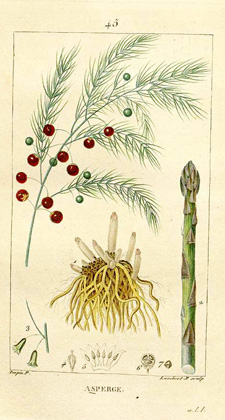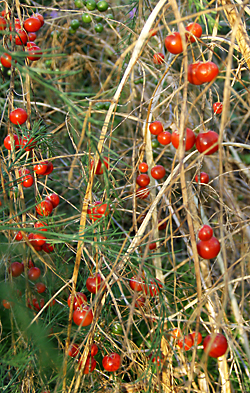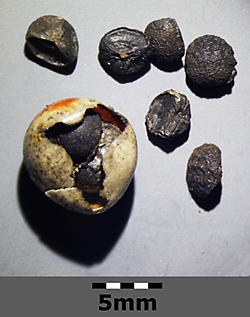





Why are crowns held in higher esteem than seed? And why are males preferred to females? No, we're not talking about arcane rules for monarchies. Let's look at the ins and outs of growing asparagus from seed.
 Males are preferred because they reportedly produce more, though smaller, spears than females do without crowding the patch with self-sown seedlings. On the other hand, plants started from seeds are more economical and less likely to harbor diseases than those grown from purchased crowns.
Males are preferred because they reportedly produce more, though smaller, spears than females do without crowding the patch with self-sown seedlings. On the other hand, plants started from seeds are more economical and less likely to harbor diseases than those grown from purchased crowns.
If you wish to harvest your own asparagus seeds you can find them inside the 3/8-inch red berries which appear on female plants in late summer or autumn. Because many gardeners only grow male plants, not all asparagus patches will produce such fruits.
After picking those berries, place them in a container of water for four days or so, changing the water about three times per day, to soak the pulp and germination inhibitors from the berries. (There should be six seeds inside each berry.) Discard the floating pulp  and any of the 4-millimeter seeds which bob on the surface, saving only the viable ones which sink.
and any of the 4-millimeter seeds which bob on the surface, saving only the viable ones which sink.
You either can plant the seeds right away or save them for later, keeping in mind that they can germinate within 5 to 6 days or take as long as 8 weeks to sprout. If you want to store the seeds, dry them on paper towels before placing them inside an envelope in a covered jar inside your refrigerator.
Sow stored or purchased seeds in late winter, about three months before you wish to transplant the seedlings into the garden in spring. Plant them in individual 2-inch seedling pots which are about 3 inches tall -- or into seedling trays with similarly sized cells -- filled with damp, sterile seed-starting mix. Sow one seed per pot or cell, covering it with 1/2 inch of the mix.
 After capping the pots or trays with plastic wrap to keep the mix damp, set them in a warm location with daytime temperatures near 75 degrees Fahrenheit and nighttime ones dropping to 65 degrees F. Once the seeds begin to sprout, remove the wrap and place the pots on a sunny windowsill or under a grow-light.
After capping the pots or trays with plastic wrap to keep the mix damp, set them in a warm location with daytime temperatures near 75 degrees Fahrenheit and nighttime ones dropping to 65 degrees F. Once the seeds begin to sprout, remove the wrap and place the pots on a sunny windowsill or under a grow-light.
Fertilize them once a week with an organic plant food at once quarter strength. For a fish and seaweed type such as 2-3-1, for example, you would mix 1/2 tablespoon of the emulsion with 1 gallon of water.
In spring, after exposing the seedlings gradually to outdoor conditions, transplant them into the garden, placing them 18 inches apart in rows at least 3 feet apart from each other. Dig a 4-inch deep hole for each seedling, but cover it only enough to leave its tip protruding from the surface of the soil. Gradually fill in more soil around the seedling as it grows until the hole is filled. You should be able to start harvesting spears the second spring after you plant the seedlings.
Photos: The cropped and enhanced asparagus berries photo is by apple2000, courtesy of Wikimedia Creative Commons and this license, and the enhanced asparagus seeds photo by Stefan Lefnaer, courtesy of Wikimedia Creative Commons and this license. The thumbnail and antique image are from Flore Medicale, Volume One by F. P. Chaumeton, courtesy of plantillustrations.org.
Copyright © www.100flowers.win Botanic Garden All Rights Reserved